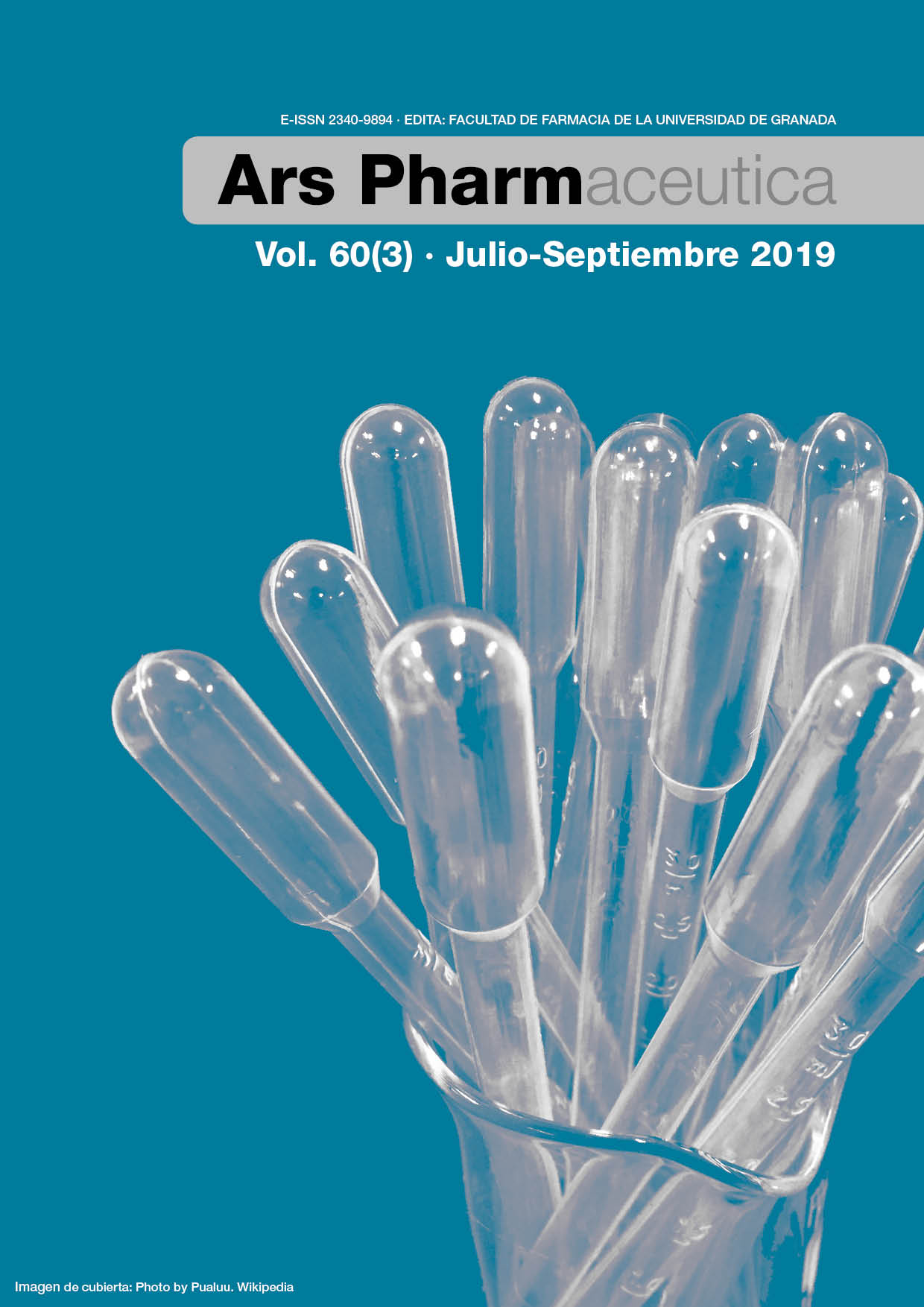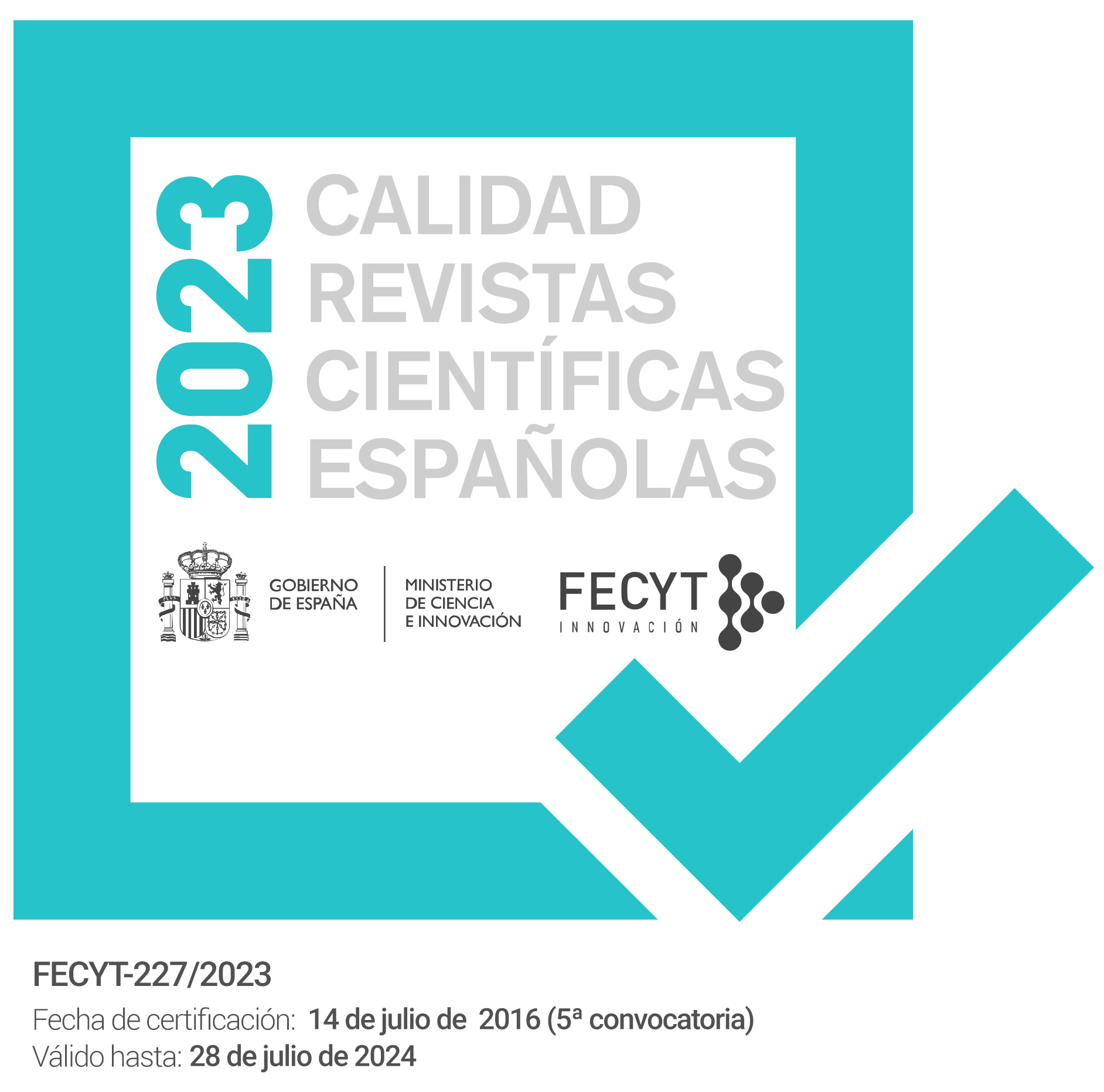Evaluación antimicrobiana de un extracto metanólico de Beauveria bassian a contra bacterias patógenas de importancia nosocomial
DOI:
https://doi.org/10.30827/ars.v60i3.9219Palabras clave:
Bacterias patógenas, Beauveria bassiana, AntimicrobialResumen
Objetivo: Se evaluó la actividad antimicrobiana de un extracto crudo de B. bassiana y dos fracciones del mismo contra bacterias de importancia clínica.
Métodos: El micelio de cepa B. bassiana se remojó en metanol durante una semana, después se evaporo en un rotovapor a 45°C aplicando vacío. El extracto metanólico se hizo pasar con dos fases móviles para obtener una fracción A y B. La fracciones A, B y el extracto crudo C se evaluaron contra las cepas Staphylococcus aureus, Escherichia coli, Klebsiella pneumoniae, Salmonella tiphy, Pseudomonas aeruginosa y Acinetobacter baumannii con la técnica de microdilución en placa.
Resultados: En la fracción A se observó un efecto antimicrobiano contra Salmonella typhi, Pseudomonas aeruginosa y Acinetobacter baumannii el crecimiento bacteriano alcanzó el 70, 60 y 83 % respectivamente. La fracción B causó un efecto antimicrobiano en Klebsiella pneumoniae, S. typhi, P. aeruginosa y A. baumannii con un crecimiento bacteriano del 62, 58, 41 y 7 % respectivamente. Y El extracto crudo no causó inhibición del crecimiento en A. baumannii, pero para el resto de la bacterias hubo un crecimiento del 56 al 88 %.
Conclusiones: Beauveria bassiana es un hongo entomopatógeno que produce diferentes metabolitos con actividad insecticida, citotóxica, antifúngica, antibiótica y antiviral. Este es el primer estudio de los efectos antimicrobianos de un extracto metanólico del hongo entomopatógeno B. bassiana contra cepas bacterianas de importancia clínica.
Descargas
Citas
Meyer, V. Genetic engineering of filamentous fungi-Progress, obstacles and future trends. Biotechnology Adavence. 2007. 26, 177-185. DOI: 10.1016/j.biotechadv.2007.12.001.
Skellam, E. Strategies for engineering natural product biosynthesis in fungi. Trends in Biotecnology. 2018. 1704, 112. DOI:10.1016/j.tibtech.2018.09.003.
Fox, E. M. & Howlett, B. J. Secondary metabolism: regulation and role in fungal biology. Current Opinion in Microbiology. 2008. 11, 481-487. DOI: 10.1016/j.mib.2008.10.007.
Deng, H. Gao, R. & Cai, Y. RISPR system in filamentous fungi: Current achievements and future directions. Gene. 2017. 627, 212-221. DOI: 10.1016/j.gene.2017.06.019.
Dhawan, M. & Joshi, N. Enzymatic comparison and mortality of Beauveria bassiana against cabbage caterpillar Pieris brassicae. Brazilian Journal of Microbiology. 2017. 48, 522-529. DOI: 10.1016/j.bjm.2016.08.004.
Rondot, Y. & Reineke, A. Endophytic Beauveria bassiana in grapevine Vitis vinifera (L.) reduces infestation with piercing-sucking insects. Biological Control. 2016.1-8. DOI: 10.1016/j.biocontrol.2016.10.006.
Quesada-Moraga, E. & Vey, A. Bassiacridin, a protein toxic for locusts secreted by the entomopathogenic fungus Beauveria bassiana. Mycological Research. 2004. 108(4), 441-452. DOI: 10.1017/S0953756204009724
Molnar, I. Gibson, D. M. & Krasnoff, S. B. Secondary metabolites from entomopathogenic Hypocrealean fungi. Natural Product Reports. 2010. 27, 1241-1275. DOI: 10.1039/c001459c.
Ozgor, E. Sevim, H. Gurpinar, O. A. & Keskin, N. Cytotoxic effect og fungal-sourced bassiatin on breast cancer cell lines. Journal of Biotechnology. 2017. 256,17-43.
Jeffs, LL. B. & Khachatourians, G. Toxic properties of Beauveria pigments on erythrocytes membranes. Toxicon. 1997. 35(8), 1351-1356. DOI: 10.1016/S0041-0101(97)00025-1.
Love, B. E. Bonner-Stewart, J. Forrest, L. A. An efficient synthesis of oosperein. Tetrahedron Letters. 2009. 50, 5050-5052. DOI: 10.1016/j.tetlet.2009.06.103.
Favilla, M. M. Gallo, A. & Altomare, C. Toxicity assessment of metabolites of fungal biocontrol agents using two diffent (Artemia salina and Daphina magna) invertebrade bioassays. Food and Chemical Toxicology. 2006. 44, 1922-1931. DOI: 10.1016/j.fct.2006.06.024.
Kouvelis, V. N., C. Wang, A. Skrobek, K. M. Pappas, M. A. Typas, and T.M. Butt. Assessing the cytotoxic and mutagenic effects of secondary metabolites produced by several fungal biological control agents with the Ames assay and the VITOTOX test. Mutat. Res.2011. 722: 1-6. DOI: 10.1016/j.mrgentox.2011.01.004.
Elsworth, J. F. & Grove, J. F. Cyclodepsipeptides from Beauveria bassiana Bals. Part 1. Beauverolides H and I. South Africa Journal of Science. 1970. 70, 270-272. DOI: 10.1039/P19770000270.
Hegedus, D. D. & Khachatourians, G. G. The impact of Biotechnology on hyphomycetous fungal insect biocontrol agents. Biotechnology Advances. 1995. 13, 455-490. DOI:10.1016/0734-9750(95)02006-O.
Vilcinskas, A. Jegorov, A. Landa, Z. Gotz, P. & Matha, V. Effects of beauverolide L and Cyclosporin A on humoral and cellular immune reponse of the greater waax moth, Galleria mellonella. Comparative Biochemistry and Physiology. 1999. 122, 83-92. DOI: 10.1016/S0742-8413(98)10082-8.
Kuzma, M. Jegerov, A. Kacer, O. & Havlicek, V. Sequencing of new beauverilodes bu high-performance liquid chromatrography and mass spectrometry. Journal of Mass Spectrometry. 2001. 36, 1108-1115. DOI: 10.1002/jms.213.
Roberts, D. W. Gupta, S. & Leger, R. J. ST. Metabolite production by entompathogenic fungi. Pesquisa Agropecuária Brasileira. 1992. 27, 325-347.
Ganassi, S. Moretti, A. & Pagliai, A. M. B. Effects of beauvericin on Schizaphis graminum (Aphidedae). Journal of Invertebrate Pathology. 2002. 80, 90-96. DOI: 10.1016/S0022-2011(02)00125-8.
Luz, C. Saladino, F. Luciano, F. B. Mañes, J. & Meca, G. Occurrence, toxicology, bioaccessibility and mitigation strategias of beauvericin, a minor Fusarium mycotoxin. Food and Chemical Toxicology. 2017. 107, 430-439. DOI: 10.1016/j.fct.2017.07.032.
Cox, R. J. & Ohagan, D. Synthesis of Isotopocally labelled 3-Amino-2-phenylpropionic acid its role as a precursor in the biosynthesis of tenellin and tropic acid. Journal of the Chemical Society, Perkin. 1991. 2537-2540. DOI: 10.1039/P19910002537.
Vega, F. E. Meyling, N. V. Luangsa-ard. & Blackwell, M. Fungal Entomopathogens. Iinsect Pathology. 2012. 171-206. DOI: 10.1016/j.jip.2008.01.008.
Liu, X. Xiang, M. & Che, Y. The living strategy of nematophagous fungi. Mycoscience. 2009. 50, 20-25. DOI: 10.1007/S10267-008-0451-3.
Vilcinskas, A., P. Kopacek, A. Jegorov, A. Vey, and V. Matha. Detection of lipophorin as the major cyclosporin-binding protein in the hemolymph of the greater wax moth Galleria mellonella. Comp. Biochem. Physiol. 1997. 117: 41- 45. DOI: 10.1016/S0742-8413(96)00235-6.
Survase, S. A. Kagliwal, L. D. Annapure, U. S. & Singhal, R. S. Cyclosporin A- A review on fermentative production, downstream processing and pharmacological applications. Biotecnhology Adavances. 2011. 29, 418-435. DOI: 10.1016/j.biotechadv.2011.03.004.
Makrlik, E., S. Bohm, and P. Vanura. Experimental and DFT study on complexation of the strontium cation with cyclosporine. A. J. Mol. Struct. 2015. 1100: 184-187. DOI: 10.1016/j.molstruc.2015.06.086.
Gindin, G. Barash, I. Harari, N. & Raccah, B. Effect of endotoxic compounds isolated from Verticillium lecanii in the sweerpotato whitefly, Bemisia Tabaci. Phytoparasitica. 1994. 22(3): 189-196. DOI: 10.1007/BF02980318.
Xu, Y. Orozco, R. Wijeratne, E. M. K. Espinosa-Artiles, P. Gunatilaka, A. A. L. Stock, S. P. & Molnar I. Biosynthesis og the cyclooligomer depsipeptide bassianolide, an insecticidal virulence factor of Beauveria bassiana. Fungal Genetics and Biology. 2009. 46, 353-364. DOI: 10.1016/j.fgb.2009.03.001
Mun, B. Park, Y. J. Sung, G. H. Lee, Y. & Kim K. H. Synthesis and antitumor activity of (-) - Bassianolide in MDA-MB 231 breast cancer cells through cell cycle arrest. Bioorganic Chemistry. 2016. 69, 64-70. DOI: 10.1016/j.bioorg.2016.09.008
Bilal, M. Rasheed, T. Iqbal, H. M. N. Hu, H. Wang, W. & Zhang, X. Macromolecular agents with antimicrobial potentialities: A drive to combat antimicrobial resistance. International Journal of Biological Macromolecules. 2017.103, 554-574. DOI: 10.1016/j.ijbiomac.2017.05.071
Devi, S. I. Lotjem, H. Devi, E. J. Potshangbam, M. Nhashangva, Ng. Bora, J. Sahoo, D. & Sharma C. Bio-mining the forest ecosytem of north east India for identification if antimicrobial metabolites from fungi through submerged fermentation. Bioresource Technology. 2017. 241, 1168-1172. DOI: 10.1016/j.biortech.2017.05.130.
Lima, M. T. N. S. Dos Santos, L. S. Bastos, R. W. Nicoli, J. R. & Takahashi J. A. Antimicrobial activity and acetylcholinesterase inhibition by extracts from chromatin modulated fungi. Brazilian Journal of Microbiology. 2018. 49, 169-176. DOI: 10.1016/j.bjm.2017.06.004.
Yogabaanu, U. Faizal Weber, J. F. Convey, P. Rizman-Idid, M y Alias, S. A. Antimicrobial properties and the influence of temperature on secondary metabolite production in cold environment soil fungi. Polar Science. 2017. 14: 60-67. DOI: /10.1016/j.polar.2017.09.005 1873-96.
Yang, M. H. Li, T. X. Wang, Y. Liu, R. H. Luo, J. & Kong, L. Y. Antimicrobial metabolites from the plant endophytic fungus Penicillium sp. Fitoterapia. 2017. 116, 72-76. DOI: 10.1016/j.fitote.2016.11.008.
Khan, N. Afroz, F. Begum, M. N. Rony, R. S. Sharmin, S. Moni, F. Hasan, C. M. Shaha, K. & Sohrab Md. H. Endophytic fusarium solani: A rich source of cytotoxic and antimicrobial napthaquinone and aza-anthraquinone derivates. Toxicology Reports. 2018. 5, 970-976.
Zhu, H. Yan, Q. An, Y. Hou, X. Zhang, T. Zhang, M. Wang, C. Xia, M. Ma, X. & Zhang, Y. Alfa-Pyrones, seconday metabolites from fungus Cephalotrichum microsporum and their bioactivities. Bioorganic Chemistry. 2019. 83, 129-134. DOI: 10.1016/j.bioorg.2018.10.022.
Rukachaisirikul, V. Arunpanichlert, J. Sukpondma, Y. Phongpaichit, S. & Sakayaroj, J. Metabolites from the endophytic fungi Botryosphaeria rhodina PSU-M35 and PSU-M114. Tetrahedron. 2009. 65, 10590-10595. DOI: 10.1016/j.tet.2009.10.084
Swathi, J. Sowjanyia, K. M. Narendra, K. Reddy, K. V. N. R. & Satya, A. K. Isolation, identification y production of biactive metabolites from marine fungi collected from coastal area of Andhra Prasdesh, India. Journal of Pharmacy Research. 2013. 6, 663-666. DOI: 10.1016/j.jopr.2013.04.052.
Shin, Y. T. Bae, S. M. & Woo, S. D. Screening and characterization of antimicrobial substances originated from entomopathogenic fungi. Journal of Asia-Pacific Entomology. 2016. 19, 1053-1059. DOI: 10.1016/j.aspen.2016.09.008.
Lozano-Tovar, M. D. Garrido-Jurado, Quesada-Moraga, E. Raya-Ortega. M. C. y Trapero-Casas, A. Metarhizium brunneum and Beauveria bassiana release secondary metabolites with antagonistic activity against Verticillium dahliae and Phytophthora megasperma olive pathogens. Crop Protection. 2017. 100 186-195. DOI: 10.1016/j.cropro.2017.06.026.
Strasser H., Abendstein D., Stuppner H., y Butt T. M. Monitoring the distribution of secondar and metabolites produced by the entomogenous fungus Beauveria bassiana with particular reference to oosporein. Mycological Research. 2000. 104: 1227-1233. DOI: 10.1017/S0953756200002963.
Descargas
Publicado
Cómo citar
Número
Sección
Licencia
Los artículos que se publican en esta revista están sujetos a los siguientes términos en relación a los derechos patrimoniales o de explotación:
- Los autores/as conservarán sus derechos de autor y garantizarán a la revista el derecho de primera publicación de su obra, la cual se distribuirá con una licencia Creative Commons BY-NC-SA 4.0 que permite a terceros reutilizar la obra siempre que se indique su autor, se cite la fuente original y no se haga un uso comercial de la misma.
- Los autores/as podrán adoptar otros acuerdos de licencia no exclusiva de distribución de la versión de la obra publicada (p. ej.: depositarla en un archivo telemático institucional o publicarla en un volumen monográfico) siempre que se indique la fuente original de su publicación.
- Se permite y recomienda a los autores/as difundir su obra a través de Internet (p. ej.: en repositorios institucionales o en su página web) antes y durante el proceso de envío, lo cual puede producir intercambios interesantes y aumentar las citas de la obra publicada. (Véase El efecto del acceso abierto).
























